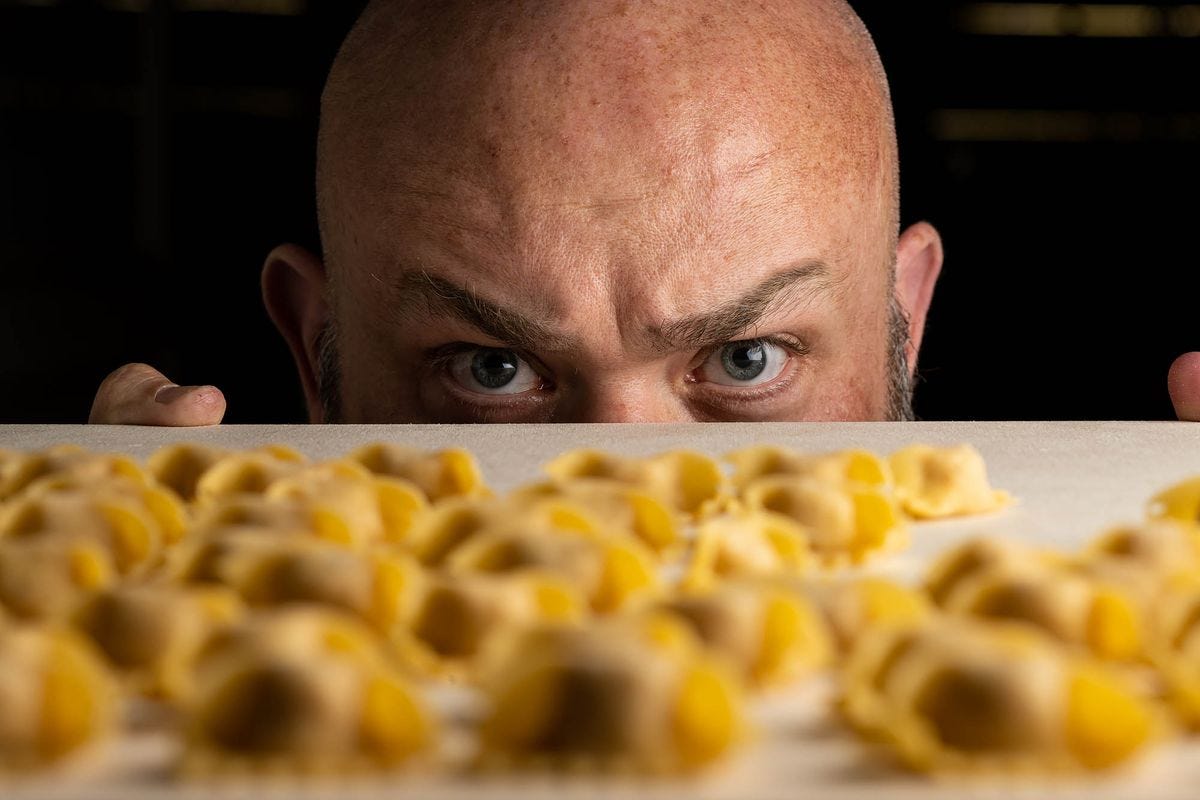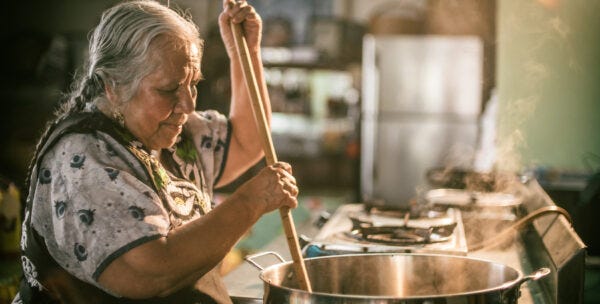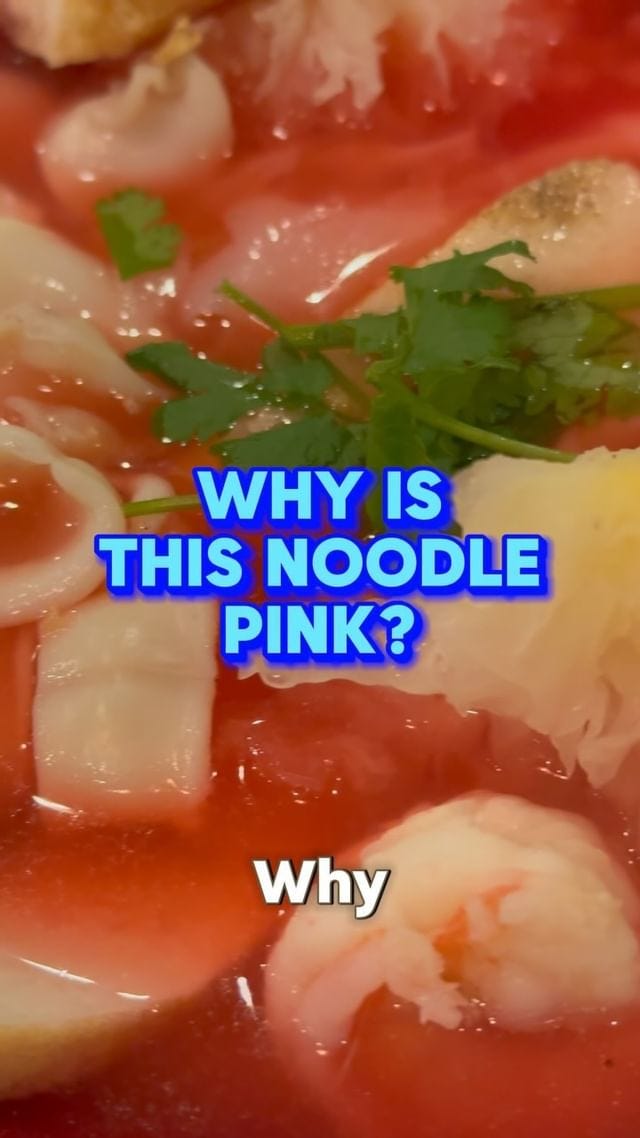Why Evan Funke's Chef's Table episode gave me the ick
Plus, the future of restaurant criticism, the eschewing of social media marketing, and LA County does something.... good?
LA FOODSTACK is a curated list of the week’s most essential food news through a Los Angeles lens. Prepared by The LA Countdown and The LA Food Podcast presented by Rusty’s Chips.
1. I’m gonna hold your hand while I tell you this
The “ick” is something I pray none of you ever experience. It’s a sudden pang of repulsion or disgust that turns an otherwise hopeful dating situation into an unrecoverable disaster. Mostly occurring at men’s expense, it could be brought on by something as innocent as the technique employed for sipping through a straw, or as we’ve seen on the latest season of Love Is Blind, the decision to engage in childish behavior such as riding a duck-shaped object. While the science undergirding the phenomenon is yet to be adequately explained, one thing is certain - you can’t come back from the ick.
If you’ve talked to me for 5 minutes you know I have strong feelings about Evan Funke. I cannot in good faith say his restaurants are bad or that he doesn’t know what he’s doing. He does, and the first episode of Chef’s Table Noodles makes that eminently clear.
Here’s a kid who was working in the Los Angeles restaurant scene when, on essentially a whim, he decided to take a three-month trip to Bologna to learn the ways of the sfogline a.k.a. the (mostly) women in charge of Emilia Romagna’s venerated handmade pasta tradition. Under the guidance of acclaimed sfoglina Alessandra Spisni, Evan found his true calling and returned to Los Angeles to open up the ill-fated Bucato, followed by the immensely successful Felix, Mother Wolf, and the eponymous Funke in Beverly Hills.
Evan’s pasta is good. My wife feels that he could stand to cook it a little more (as did Jonathan Gold, by the way), but you can’t deny the artisanship and quality of what he and his team do. Watching the painstaking process of rolling out a sfoglia on Chef’s Table even somewhat justifies the high price, albeit dropping $48 on tagliatelle al ragu will never be an easy pill to swallow for some.
It’s the attitude that gives me the ick. In the past, it’s rubbed me the wrong way to hear Evan describe himself as a “custodian of Italian culture,” a claim he repeats on the Chef’s Table episode.
Technically, Evan is doing everything “right.” While the discussions of appropriating other cultures’ cuisines are better left to other platforms, the consensus seems to be that the bare minimum required for chefs cooking the food of other cultures is to do thorough research beforehand and acknowledge the food’s provenance throughout. Evan has done both, going so far as to include the names of the women who taught him the pasta shapes on the menu at Funke.
The thing about custodians is that they are in the background. What they preside over as custodians takes center stage. Even when Evan answers “Why pasta?” on Chef’s Table, it’s all about him. He needed purpose. He needed direction. He became obsessed with mastering pasta. Pasta was merely in the line of fire. If he had spent three months in Tokyo instead of Bologna, we might be talking about how hard it is to get a reservation at Funke Sushi.
You can’t get away from the fact that, as Evan’s career has progressed, he has increasingly become the focus of it. Even though the women’s names are on the menu, the name on the building is… Funke. The women don’t get to go on Jimmy Kimmel, open restaurants in Miami and Las Vegas, or pal around with Hollywood’s elite. Evan does. This isn’t just about pasta. It’s about viral mortadella sandwiches and Vanity Fair Oscar parties. And, deeper than that, it’s about someone with something to prove using pasta to do so.
I’m not mad at Evan’s success. Does it feel a little uncomfy that he profits while the women he gives lip service to don’t? Sure. But I’m not mad - the women have seemingly given him their blessing in making pasta his entire personality.
But the most Italian thing Evan could do is cut the shit. Pasta is a lucrative business for you, and it’s also seemingly helped you fill a void. And that’s okay. That’s beautiful. But don’t act like you’re doing something for my culture, like some sort of Mattarello-wielding Guardian of the Galaxy. That doesn’t just make the $48 bolognese feel offensive. It makes it ick-inducing.
2. Is “discourse” what’s really missing from modern-day restaurant criticism?
This is TASTE’s Matt Rodbard conducted a fascinating interview with Eater NY critic-turned-The LO Times Substacker Ryan Sutton. They covered a wide range of topics, including how Ryan is managing to subsist on Substack subscriptions and how he thinks of the rise of influencers like Keith Lee and MuslimFoodies.
The crux of the interview, however, focused on how Ryan thinks about food criticism amidst the changing landscape of food media. Three questions emerged for me upon hearing Ryan’s musings:
Substack is great, but is it just the gig worker-fication of food writers? There’s definitely something to be said for being your own editor and having a direct relationship with readers, but listening to Ryan discuss the low-margin economics, I question how sustainable it is for food writers who need to pay for their food in order to remain objective.
What if critics became… influencers? Okay, not actual influencers, but hear me out. Ryan touched on the traditional role of critics, which was to give the public a resource to consult when choosing where to spend their hard-earned dollars. Does that translate into consumers needing an 800-word piece on SoHo’s latest sushi experience? I don’t think so. In this day and age, I feel like consumers are happy to get that information from 90-second TikTok videos. What if critics - REAL critics, like Bill Addison and Ryan Sutton - took to a social-first approach? What would be so wrong about that?
What does discourse look like? Ryan lamented that one negative effect of the dearth of food media budgets and, therefore, the diminishing number of critics, is the absence of discourse between critics. The idea is that consumers have the best information when they are exposed to multiple, varied viewpoints and can use all of the information to make up their own minds. Noble in theory, but what does that actually look like? The only example I can think of is when Bill Esparza publicly took issue with the overarching media adulation of Villa’s Tacos. The issue with that example is… nobody responded to him! I agree that discourse might make for a richer conversation, but I don’t think the issue is a lack of critics - I think it’s a fear of confrontation.
3. Restaurants want to meet you IRL

THE New York Times’ Rachel Sugar wrote a very demure article this week exploring why restaurants are becoming increasingly mysterious online:
There are several bits of information you might wish to know before going to a restaurant. For example: When does it open? What can you eat there, and how much does it cost? These are just the sort of details that appear on a restaurant’s website, traditionally a digital repository of facts about your prospective meal.
Unless they don’t. Lately, a number of establishments — not under-the-radar mom-and-pops, but chic or pedigreed restaurants, the kind of places that appear on must-try lists — are withholding the details in favor of an air of mystery…
[T]ight-lipped restaurateurs insist they aren’t gate-keeping or being coy for coyness’ sake. On the contrary, by not sharing too many details online, they say they’re trying to revive a long-lost spirit of romance and adventure. The low-information restaurant does not want you to game out your visit: They want you to surrender to the pleasure of it.
Highland Park newcomer Sam’s Place is taking things to the next level, by forgoing social media and even a website altogether. Co-owner Scotty Cantino offered this reasoning when speaking with The LA Times’ Stephanie Breijo:
“We’re not trying to make it feel like a speakeasy or anything like that, where it’s exclusive,” Cantino says, “but I do think that we want the experience to start when you walk in the door, and not on your phone or on the internet. I feel like it’s more likely people will have a good time if their first interaction is when they come in, than judging how bad of a photographer I am on Instagram.”
Whether they’re doing it as guerrilla marketing or whether they’re doing it to save money on social media budgets, I’m interested to see how this strategy plays out.
4. LA restaurants just got a lot more homey
KTLA’s Travis Schlepp reports on some *gasp* helpful new moves made by the LA County government:
Los Angeles County is kickstarting a new permit program for home cooks with an entrepreneurial spirit who are interested in operating a miniature restaurant out of their homes.
The County Department of Public Health announced the new Microenterprise Home Kitchen Operation (MEHKO) Program, which began accepting applications Monday.
The at-home food business program will allow residents to operate a food facility out of their private kitchens, allowing them to store, handle, prepare and serve food to the public if appropriately permitted.
In theory, this sounds great. But there are some catches:
Those wishing to start a permitted home restaurant must not have more than one full-time employee other than family or household members, and every person involved in the operation must obtain food safety certification from the State of California. Food will also need to be prepared, cooked and served or delivered on the same day it’s made.
The businesses can serve no more than 30 meals per day or 90 meals per week, with an annual revenue not to exceed $100,000 per year.
Operators can’t resell food to other facilities and can’t use third-party delivery apps like DoorDash or UberEats. Alcohol can’t be part of the service without appropriate licensing from the California Department of Alcohol Beverage Control.
While this seems like a step in the right direction, I do question whether 90 meals per week is enough. It sounds fine for someone looking to host a pop-up, but what about a popular operation like Comedor Tenchita? Does this mean they’ll have to scale back or risk being fined?
As with any policy, the kinks will need ironing out. But for now, credit where credit is due.
5. Best thing I ate this week? Yen Ta Fo from Ruen Pair in Thai Town
I’ll confess that prior to embarking on my quest to try 100 epic LA noodle dishes in 365 days, my Thai food order was painfully basic. Give me a Pad of some variety, throw in a curry, and round it out with a papaya salad or a spicy larb. Happy days.
Now, however, ordering has become vastly more complex. If there’s a boat noodle I’m hard-pressed to say no. Guay jub? Sign me up. Tom yum? Why not?
The latest entry into my roster is Yen Ta Fo - a seafood-laden soup dyed pink with a pungent dollop of fermented red bean curd. The wide noodles perfectly sop up the broth and the funky bean curd works surprisingly well with the seafood-induced salinity.
Yen Ta Fo? More like YES Ta Fo! I’m sorry.
Other stories to chow down on…
Eater’s Meg Wilcox looked at all that restaurants are doing to cut their carbon footprints. From electrifying kitchens to improving their HVAC situations, one thing is clear - becoming greener comes at a cost. My question is this - at a time when restaurants are struggling to stay alive, how much can we realistically expect them to do?
SF Gate’s Farley Elliott flew to Mexico City to try “the world’s only Michelin taco stand.” That’s Michelin-starred, not Michelin Bib Gourmand of which there are many.
Look out, health-conscious parents with money to burn - Erewhon now offers kids’ meals. They cost $20 in comparison to McD’s $5 ones. I first saw the news in Emily Sundberg’s Feed Me newsletter.
Let’s end with dessert. Mexico City’s most famous churro shop, El Moro, is coming to Echo Park. Matthew Kang reports for Eater.
This week on The LA Food Podcast presented by Rusty’s Chips…
We get into the nitty-gritty of the Evan Funke Chef’s Table episode. And lest you think the thoughts shared in this newsletter are a spoiler, just wait. There’s a lot more.
Plus, we discuss our thoughts on the future of restaurant criticism per Ryan Sutton’s interview in This is TASTE, whether home restaurants are a good thing, and the tension between keeping restaurants alive and asking them to be more sustainable.
Want more? Follow The LA Countdown on Instagram, TikTok, and YouTube. Listen to The LA Food Podcast presented by Rusty’s Chips wherever podcasts are heard and follow @lafoodpod on Instagram.






I might have missed it but it seems they focused on Felix and Funke but never mentioned Mother Wolf. He definitely puts in the work but feels this episode is lacking in many ways.
Great segment. Especially the part where you said “don’t act like you’re doing something for our culture”. Italians love when people embrace our culture and even borrow from it. But you’d better damn well respect it when you are.